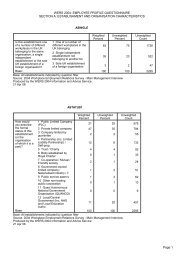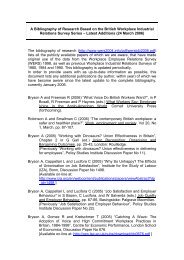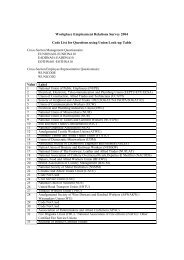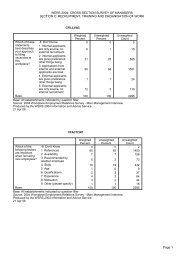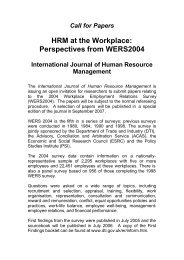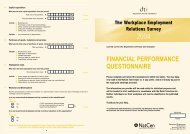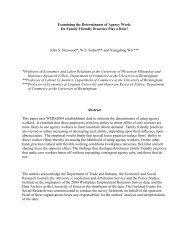A multilevel analysis of job satisfaction in Britain - WERS 2004
A multilevel analysis of job satisfaction in Britain - WERS 2004
A multilevel analysis of job satisfaction in Britain - WERS 2004
Create successful ePaper yourself
Turn your PDF publications into a flip-book with our unique Google optimized e-Paper software.
1. IntroductionEconomists ventured <strong>in</strong>to study<strong>in</strong>g issues <strong>of</strong> subjective well-be<strong>in</strong>g and/or <strong>job</strong><strong>satisfaction</strong> somewhat later than psychologists and sociologists. None the less,they have been fasc<strong>in</strong>ated by issues surround<strong>in</strong>g <strong>job</strong> <strong>satisfaction</strong> for it hasimportant economic consequences. In the economics circle <strong>job</strong> <strong>satisfaction</strong> hastraditionally been regarded as an important predictor <strong>of</strong> such labour marketbehaviours <strong>of</strong> workers as quit and absenteeism (e.g. Hammermesh 1997,Freeman 1978, Akerl<strong>of</strong> et al. 1988, Clark et al. 1998, Shields & Price 2002,Kristensen & Westergard-Nielsen <strong>2004</strong>, Levy-Garbous et al. 2005). Both <strong>in</strong>economics and other areas <strong>of</strong> social research <strong>job</strong> <strong>satisfaction</strong> has also been l<strong>in</strong>kedto <strong>in</strong>dividual well-be<strong>in</strong>g (Argyle 1989, Clark 1997, Sousa-Poza and Sousa-Poza2001, Kahneman & Krueger 2006), <strong>job</strong> performance and productivity (e.g.Iaffaldano & Much<strong>in</strong>sky 1985), organisational performance (Ostr<strong>of</strong>f 1992) and<strong>in</strong>novation (Shipton, et al. 2006).There has been a grow<strong>in</strong>g <strong>in</strong>terest <strong>in</strong> establish<strong>in</strong>g the determ<strong>in</strong>ants <strong>of</strong> <strong>job</strong><strong>satisfaction</strong> and many have argued as such (Hammermesh 2001). While mostprevious studies sought to relate <strong>job</strong> <strong>satisfaction</strong> to a host <strong>of</strong> worker and <strong>job</strong>attributes (e.g. Clark 1996, Gazioglu and Tansel 2006), others have paid muchattention to some specific correlates <strong>of</strong> <strong>job</strong> <strong>satisfaction</strong>. These <strong>in</strong>clude, amongothers, <strong>job</strong> <strong>satisfaction</strong> and gender (Clark 1997, Bender et al. 2005), <strong>job</strong><strong>satisfaction</strong> and age (Clark et al. 1996), <strong>job</strong> <strong>satisfaction</strong> and wage (Borjas 1979,Clark et al. 1998, Clark 1999, Lydon & Chevalier 2002), <strong>job</strong> <strong>satisfaction</strong> andrelative <strong>in</strong>come (Clark and Oswald 1994, 1996), <strong>job</strong> <strong>satisfaction</strong> and unions(Borjas 1979, Berger et al. 1983, Bryson et al. <strong>2004</strong>; 2006), <strong>job</strong> <strong>satisfaction</strong> andwork environment (Idson 1990), <strong>job</strong> <strong>satisfaction</strong> and work relations andmanagement (Gazioglu & Tansel <strong>2004</strong>), <strong>job</strong> <strong>satisfaction</strong> and racial composition(Maume & Sebastian 2007).Though there exist such a long list <strong>of</strong> research <strong>in</strong>to different aspects <strong>of</strong> <strong>job</strong><strong>satisfaction</strong> and/or its consequences, there still exists a room for further<strong>in</strong>g ourunderstand<strong>in</strong>g <strong>of</strong> the determ<strong>in</strong>ants <strong>of</strong> <strong>job</strong> <strong>satisfaction</strong> <strong>in</strong> particular. At least twoimportant reasons can be cited <strong>in</strong> this respect. First, almost all <strong>of</strong> the research<strong>in</strong>to the determ<strong>in</strong>ants <strong>of</strong> <strong>job</strong> <strong>satisfaction</strong> fails to take <strong>in</strong>to account unobserved<strong>in</strong>dividual-level and/or workplace-level heterogeneity. 1 One important lesson thatresearch <strong>in</strong> labour economics, particularly where there is a l<strong>in</strong>ked/matchedemployer-employee data, underscores is the importance <strong>of</strong> such unobservedfactors <strong>in</strong> determ<strong>in</strong><strong>in</strong>g labour market outcomes (see, for example, Abowed et al.1999). 2 Job <strong>satisfaction</strong> as an outcome may not be too different <strong>in</strong> this regard,and one needs to account for unmeasured heterogeneity to address such issues as1 The few exceptions <strong>in</strong>clude W<strong>in</strong>kelmann & W<strong>in</strong>kelmann (1998), Clark et al. (2006), whoaccount for unmeasured effects us<strong>in</strong>g longitud<strong>in</strong>al data, and Bryson et al. (<strong>2004</strong>, 2006) who usethe 1998 sweep <strong>of</strong> <strong>WERS</strong>.2 Abowed et al. (1999) have used a matched longitud<strong>in</strong>al data. In <strong>WERS</strong> it is workplaces, and notemployees, that are followed <strong>in</strong> each <strong>of</strong> the surveys. Given this, the <strong>multilevel</strong> model <strong>of</strong>fers thebest opportunity to account for employee-level and workplace-level heterogeneity <strong>in</strong> the context<strong>of</strong> the cross-section (<strong>WERS</strong> <strong>2004</strong>) data this study uses.3



